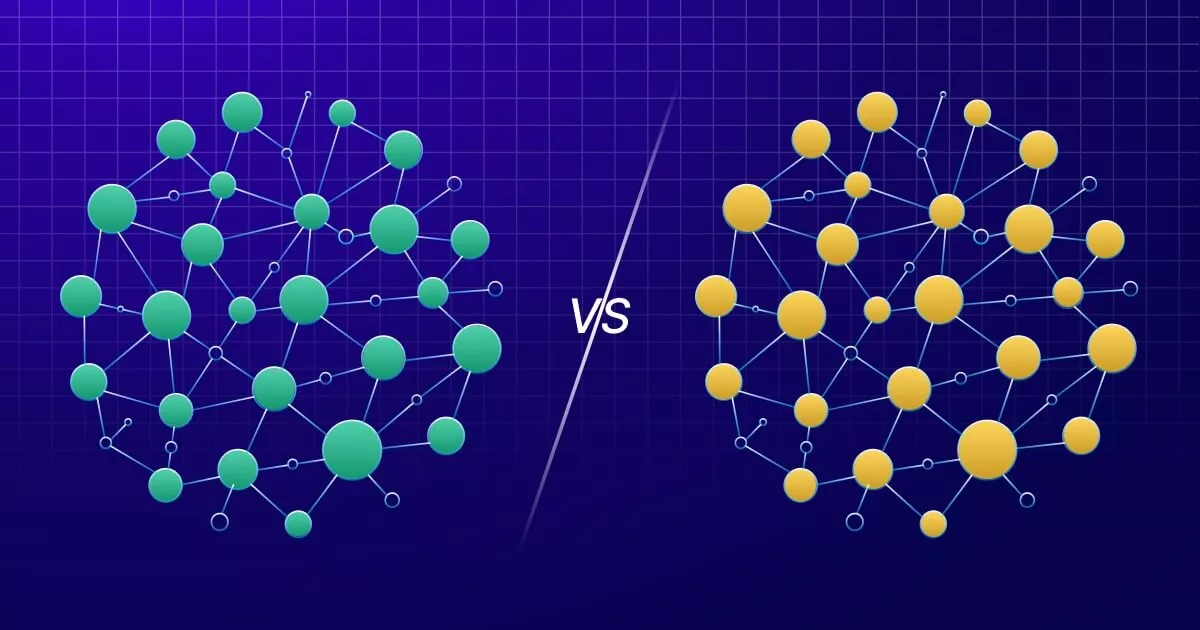
In the world of blockchain development, understanding the difference between mainnet & testnet is crucial.
Mainnet represents the live, operational network of a blockchain where real economic transactions take place.
On the other hand, the testnet provides a separate network environment for developers to test and experiment with new features before deploying them on the mainnet.
This article explores the distinctions between mainnet & testnet, highlighting their significance in ensuring the stability, security, and success of blockchain projects.
What is Mainnet?
Mainnet refers to the main network or production-ready version of a blockchain or cryptocurrency system. It is the fully operational and decentralized version of a blockchain protocol where transactions and other operations take place with real economic value.
The mainnet is the culmination of the development process, typically preceded by a testnet or a series of test networks used to identify and fix bugs or vulnerabilities.
In blockchain technology, a mainnet represents the live implementation of the protocol, where users can interact with the network, create accounts, initiate transactions, and participate in various consensus mechanisms such as proof-of-work or proof-of-stake.
The mainnet is designed to be secure, scalable, and reliable, supporting the full functionality of the blockchain platform.
Launching a mainnet is a significant milestone for blockchain projects as it signifies transitioning from a theoretical concept to a practical and functioning system. It enables users to leverage the decentralized features of the blockchain, such as immutability, transparency, and trustlessness, without relying on centralized intermediaries.
Once a mainnet is established, developers can build decentralized applications (dApps), and users can transact and interact with these applications using native cryptocurrency or blockchain tokens.
What is Testnet?
Testnet refers to a separate network environment blockchain developers use to test and experiment with new features, functionalities, and upgrades before deploying them on the mainnet.
It serves as a testing ground for developers, allowing them to identify and address bugs, vulnerabilities, or performance issues before launching the software on the live, production-ready network.
Testnets mimic the mainnet environment to a certain extent, but they operate with test tokens or cryptocurrencies with no real economic value. These tokens are distributed freely or obtained through faucets, enabling developers to simulate transactions and interactions without incurring financial risks.
Testnets may also have a faster block time or altered consensus mechanisms to facilitate rapid testing and experimentation.
By deploying applications and smart contracts on testnets, developers can validate the functionality and behavior of their code in a controlled environment. They can also simulate various scenarios and edge cases to ensure the stability and reliability of the software.
Additionally, testnets allow for collaborative testing, enabling developers from different projects or teams to interact and identify potential compatibility issues.
Testnets provide a crucial step in the development lifecycle of blockchain projects, enabling thorough testing and refinement of software components. Once the code and features have undergone rigorous testing on the testnet and any issues have been addressed, they can be confidently deployed on the mainnet for real-world use, reducing the risk of critical failures or security breaches.
Transitioning from Testnet to Mainnet
Transitioning from testnet to mainnet is critical in developing a blockchain project.
It involves migrating the project’s code, tokens, and infrastructure from the testing environment to the live, production-ready network. This transition signifies the readiness of the blockchain platform for real-world usage and the deployment of the project’s economic model.
The process of transitioning from testnet to mainnet typically involves several important steps.
- First, the project’s code and smart contracts are thoroughly tested and audited on the testnet to ensure their functionality, security, and stability.
Note: Any bugs, vulnerabilities, or issues identified during testing are addressed and resolved.
- Next, token deployment is a crucial aspect of the transition. Tokens used on the testnet, often called test tokens or play tokens, must be migrated or swapped with the tokens used on the mainnet.
Note: This process ensures value continuity for token holders and allows them to utilize the tokens for real economic transactions on the live network.
Additionally, the infrastructure supporting the blockchain network is scaled up and optimized for the mainnet. This includes ensuring the network nodes, consensus mechanisms, and other components are robust, secure, and capable of handling the anticipated transaction volume and user activity.
During the transition, communication, and awareness play a significant role. The project team communicates the launch of the mainnet to the community, exchanges, and other stakeholders, informing them about the token swap process and the new economic model.
Mainnet vs. Testnet: Understanding the Difference
Mainnet & testnet are two distinct network environments used in blockchain technology.
Mainnet refers to the live, production-ready network of a blockchain protocol. It is the fully operational version where real transactions and operations take place using the native cryptocurrency or tokens.
The mainnet is decentralized, secure, and designed to handle real-world economic activity. Users can create accounts, transact, and interact with decentralized applications (dApps) built on the blockchain.
On the other hand, a testnet is a separate network environment specifically designed for testing and experimentation purposes. It serves as a sandbox for developers to test new features, upgrades, or smart contracts before deploying them on the mainnet.
Testnets closely resemble the mainnet in terms of functionality but operate with test tokens with no real economic value. This allows developers to simulate transactions and interactions without incurring financial risks. Testnets enable developers to identify and resolve any bugs, vulnerabilities, or performance issues before releasing their software on the live network.
To summarize, the key distinction between the mainnet & testnet is that the mainnet is the operational network where real economic activity occurs, while the testnet is a dedicated network for testing and development purposes. Testnet provides a controlled environment for developers to validate and refine their code before deploying it on the mainnet, ensuring a more stable and reliable user experience.
Conclusion
Grasping the disparity between the mainnet & testnet is essential for blockchain developers.
Mainnet represents the live network where actual transactions occur, while the testnet serves as a dedicated environment for testing and refining blockchain software.
Thus, awareness of the nuances between mainnet & testnet empowers developers to create robust and successful blockchain projects.
FAQs
1. What is the difference between mainnet & testnet in blockchain development?
The mainnet is a blockchain’s live, operational network where real transactions occur with actual economic value. It is decentralized and used by users for everyday operations.
Testnet, on the other hand, is a separate network environment for developers to test and experiment with new features and upgrades before deploying them on the mainnet. It operates with test tokens and allows developers to identify and fix bugs or vulnerabilities without risking real assets.
2. Why is it important to test on a testnet before deploying on the mainnet?
Testing on a testnet is crucial before deploying on the mainnet to ensure the stability, security, and functionality of the software. It allows developers to identify and resolve bugs, vulnerabilities, or performance issues in a controlled environment without affecting real users or assets.
Testing on the testnet minimizes the risk of critical failures or security breaches on the mainnet, ensuring a smoother and more reliable user experience.
3. How does the transition from testnet to mainnet impact token deployment and economic models?
The transition from testnet to mainnet involves token deployment and can impact the economic models of a blockchain project.
During the transition, tokens may undergo a migration process, where they are moved from the testnet to the mainnet. This migration ensures the compatibility and continuity of value for token holders.
Additionally, the transition to the mainnet signifies the launch of a fully operational system, allowing users to utilize tokens for real economic transactions and participate in the economic activities supported by the blockchain platform.




